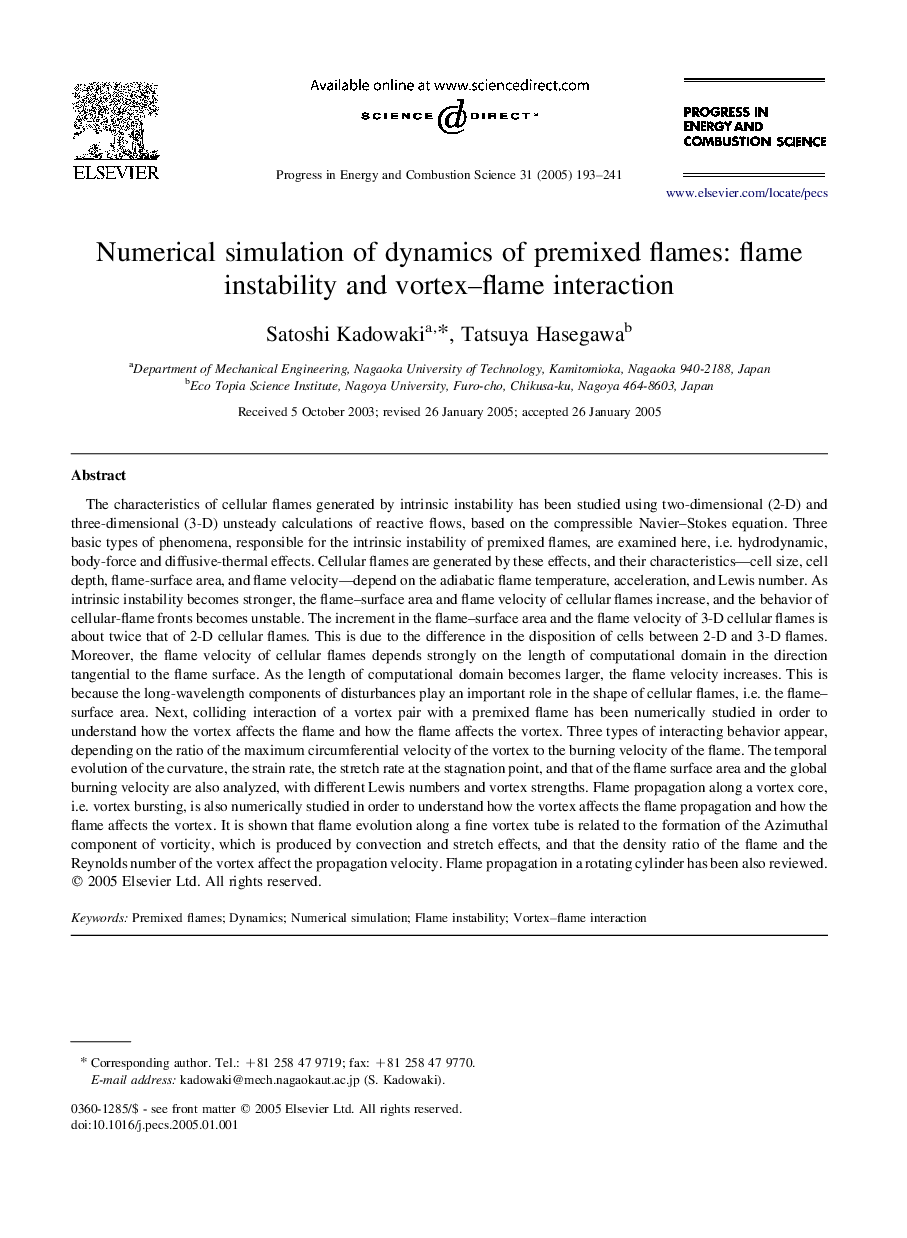| کد مقاله | کد نشریه | سال انتشار | مقاله انگلیسی | نسخه تمام متن |
|---|---|---|---|---|
| 10281594 | 466345 | 2005 | 49 صفحه PDF | دانلود رایگان |
عنوان انگلیسی مقاله ISI
Numerical simulation of dynamics of premixed flames: flame instability and vortex-flame interaction
دانلود مقاله + سفارش ترجمه
دانلود مقاله ISI انگلیسی
رایگان برای ایرانیان
کلمات کلیدی
موضوعات مرتبط
مهندسی و علوم پایه
مهندسی شیمی
مهندسی شیمی (عمومی)
پیش نمایش صفحه اول مقاله

چکیده انگلیسی
The characteristics of cellular flames generated by intrinsic instability has been studied using two-dimensional (2-D) and three-dimensional (3-D) unsteady calculations of reactive flows, based on the compressible Navier-Stokes equation. Three basic types of phenomena, responsible for the intrinsic instability of premixed flames, are examined here, i.e. hydrodynamic, body-force and diffusive-thermal effects. Cellular flames are generated by these effects, and their characteristics-cell size, cell depth, flame-surface area, and flame velocity-depend on the adiabatic flame temperature, acceleration, and Lewis number. As intrinsic instability becomes stronger, the flame-surface area and flame velocity of cellular flames increase, and the behavior of cellular-flame fronts becomes unstable. The increment in the flame-surface area and the flame velocity of 3-D cellular flames is about twice that of 2-D cellular flames. This is due to the difference in the disposition of cells between 2-D and 3-D flames. Moreover, the flame velocity of cellular flames depends strongly on the length of computational domain in the direction tangential to the flame surface. As the length of computational domain becomes larger, the flame velocity increases. This is because the long-wavelength components of disturbances play an important role in the shape of cellular flames, i.e. the flame-surface area. Next, colliding interaction of a vortex pair with a premixed flame has been numerically studied in order to understand how the vortex affects the flame and how the flame affects the vortex. Three types of interacting behavior appear, depending on the ratio of the maximum circumferential velocity of the vortex to the burning velocity of the flame. The temporal evolution of the curvature, the strain rate, the stretch rate at the stagnation point, and that of the flame surface area and the global burning velocity are also analyzed, with different Lewis numbers and vortex strengths. Flame propagation along a vortex core, i.e. vortex bursting, is also numerically studied in order to understand how the vortex affects the flame propagation and how the flame affects the vortex. It is shown that flame evolution along a fine vortex tube is related to the formation of the Azimuthal component of vorticity, which is produced by convection and stretch effects, and that the density ratio of the flame and the Reynolds number of the vortex affect the propagation velocity. Flame propagation in a rotating cylinder has been also reviewed.
ناشر
Database: Elsevier - ScienceDirect (ساینس دایرکت)
Journal: Progress in Energy and Combustion Science - Volume 31, Issue 3, 2005, Pages 193-241
Journal: Progress in Energy and Combustion Science - Volume 31, Issue 3, 2005, Pages 193-241
نویسندگان
Satoshi Kadowaki, Tatsuya Hasegawa,